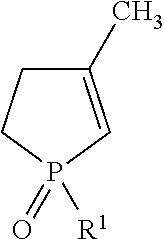Method Of Producing Phospholene Oxide
a technology of phospholene oxide and phospholene oxide, which is applied in the field can solve the problems of high cost of reactants used to form phospholene oxide, low yield of phospholene oxide, and time-consuming and inefficient traditional methods of producing phospholene oxides
- Summary
- Abstract
- Description
- Claims
- Application Information
AI Technical Summary
Benefits of technology
Problems solved by technology
Method used
Image
Examples
example 1
Production of 3-methyl-1-phenyl-2-phospholene oxide (MPPO)
[0039]Example 1 is a method of producing MPPO in accordance with the instant disclosure. The reactants, solvents, and additives, and amounts thereof used to form the MPPO are set forth in Table 1 below.
[0040]To start, a reactor is evacuated, i.e., a vacuum applied, and a vacuum leak check is performed to determine a vacuum loss. The reactor maintains vacuum, with the vacuum loss being less than 5 mm Hg (0.1 psi) over 10 minutes. After the vacuum leak check, the vacuum is withdrawn and the reactor is pressurized with nitrogen to 2586 mm Hg (50 psi). A pressure leak check is again performed to determine a pressure loss. The reactor maintains pressure, with the pressure loss being less than 13 mm Hg (0.25 psi) over 15 minutes. The reactor is then cooled to a temperature of about 25° C. (77° F.). A halogenated hydrocarbon solvent and an antioxidant are first charged into the reactor and a nitrogen blanket is applied to the reacto...
example 2
Production of 3-methyl-1-phenyl-2-phospholene oxide (MPPO)
[0043]Example 2 is also a method of producing MPPO in accordance with the instant disclosure. The reactants, solvents, and additives, and amounts thereof used to form the MPPO are set forth in Table 2 below.
[0044]To start, a reactor is evacuated, i.e., a vacuum applied, and a vacuum leak check is performed to determine a vacuum loss. The reactor maintains vacuum, with the vacuum loss being less than 5 mm Hg (0.1 psi) over 10 minutes. The vacuum is withdrawn and the reactor is pressurized with nitrogen to 2586 mm hg (50 psi). After the vacuum leak check, a pressure leak check is again performed to determine a pressure loss. The reactor maintains pressure, with the pressure loss being less than 13 mm hg (0.25 psi) over 15 minutes. The reactor is then cooled to a temperature of about 25° C. (77° F.). The halogenated hydrocarbon solvent and the antioxidant are first charged into the reactor and a nitrogen blanket is then applied...
PUM
| Property | Measurement | Unit |
|---|---|---|
| molar ratio | aaaaa | aaaaa |
| temperature | aaaaa | aaaaa |
| molar ratio | aaaaa | aaaaa |
Abstract
Description
Claims
Application Information
 Login to View More
Login to View More - R&D
- Intellectual Property
- Life Sciences
- Materials
- Tech Scout
- Unparalleled Data Quality
- Higher Quality Content
- 60% Fewer Hallucinations
Browse by: Latest US Patents, China's latest patents, Technical Efficacy Thesaurus, Application Domain, Technology Topic, Popular Technical Reports.
© 2025 PatSnap. All rights reserved.Legal|Privacy policy|Modern Slavery Act Transparency Statement|Sitemap|About US| Contact US: help@patsnap.com



